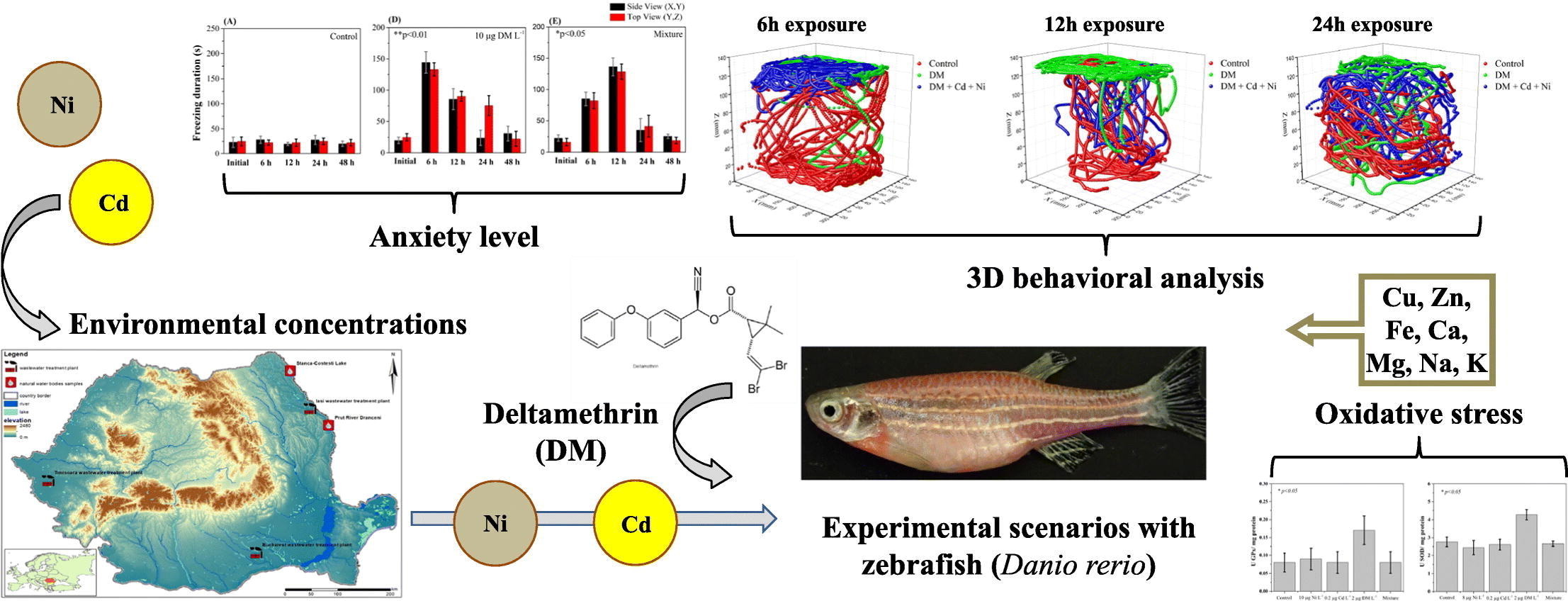The ABE research group is currently focusing on:
❏ Toxicity tests on zebrafish (Danio rerio) model
Assessment of chemical mixture effects

The majority of toxicological studies have focused on effects induced by individual chemical exposure, rather than chemical mixtures. However, compared to single exposure, mixed contaminants may elicit combined toxic impacts on organisms, including additive, antagonistic, and synergistic effects. Therefore, further understanding of the joint toxic impacts of chemical mixtures is needed. For that, we have studied the acute effects of cadmium, nickel and deltamethrin as individual toxicants and as a mixture on the behavioral responses, oxidative stress (SOD and GPx), body electrolytes and trace metals profiles of zebrafish (Danio rerio).
Pharmacological tests on zebrafish model (Danio rerio) for neurological applications

Zebrafish (Danio rerio) is a promising animal model for neuroscience research and drug discovery approaches because of their complex behavioral and phydiological phenotypes, high physiological/gentic homology to humans and cost effective. Further, hundreds of chemicals can be screened rapidly in vivo for therapeutic and toxic effects that may be related to neurodegenerative diseases. In addition, reconstruction of fish swim path in 3D (the Track3D method) consolidates behavioral data and provides a novel way to investigate the neurobiological basis of social behavior and to detect major drug-involved effects. Our group is exploiting the zebrafish responses to various neuroactive drugs in order to distinguish between various drugs classes and to study the therapeutic and toxic effects of novel neuroactive compounds.
❏ Small-scale plastics: occurence, identification and effects

In recent years, the contamination of marine and freshwater environments with plastic debris have drawn the scientific community and the public attention. Due to the high production of plastics coupled with their physic-chemical properties such as buoyancy and very slow (bio)degradation rate, as well as with the ineffective and irresponsible waste collection and recycling, it is only a question of time when synthetic polymers became a global ecological and environmental problem. While, the plastic litter composed from large pieces can be easily removed from environment and sent to recycling process, the small plastic particles (smaller than 5 mm) are almost impossible to be removed from the environmental medium. Consequently, a more serious and widespread ecological impact is expected for the small plastic particles. The plastic particles can be classified by their shape into pellet, fragment, fiber, film and styrofoam and by their size in macroplastics (>25 mm), mesoplastics (between 5 and 25 mm) and microplastics (smaller than 5 mm). Also, a distinction can be performed between primary and secondary MP. Primary MP comprise the manufactured plastics of microscopic size, for example those used in cosmetics and exfoliating scrubs or industrial pellets that served as precursor for manufactured plastic products. Secondary MP derived from macroscopic debris due to the influence of mechanical forces, oxidation and photochemical processes. Our group is exploring the abundance and distribution of microplastics in various freshwater ecosystems, as well as their potential toxicological effects on freshwater biota.
❏ Freshwater quality monitoring and research

The accumulation of toxic metals to hazardous levels in freshwater
ecosystems has become a problem of increasing concern. It is clear that metals enter in
the aquatic systems from various sources and they can be readily transported from one system to another. Thus,
the toxic metals can follow diverse route of bioaccumulation in the organism's body mass,
routes that are similar to electronic circuits, but far more complex due to their hierarchy levels.
Total concentrations of Cu, Li, Na, Mg, K, Ca, Rb, Cs, Ti, Zr, Nb, Mn, Fe, Co, Ag, Au, In, Tl, Sn,
Cd, Pb, Cr and Ni in many surface waters, sediments and biota samples
have been assessed in our laboratory. The sublethal effects of long-term exposure to low environmental
metal concentrations are at the forefront of our investigations.
❏ Aquatic biodiversity and preservation

Benthic macroinvertebrates associations are unified into the structure of the great majority of continental aquatic ecosystems (streams, rivers, lakes and puddles), generally representing the numerical and/or biomass dominant components and the major links of the channels of matter and energy transfer. In many parts of the world, water is a limiting factor of the economy, food production and the spread of populations. The expanding of pollution is increasing pressures by depletion of underground springs, lowering groundwater levels and deterioration of ecological systems. In many parts of the world, water is a limiting factor of the economy, food production and the spread of populations. The expanding of pollution is increasing pressures by depletion of underground springs, lowering groundwater levels and deterioration of ecological systems. Our group is investigating the relation between environmental conditions modifications (like chemistry and climate) and biodiversity structure changes of benthic invertebrates.